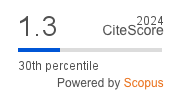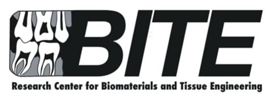Confirmation of the potential mechanism of pentagamavunon-0 against temporomandibular arthritis using bioinformatic approaches
Downloads
Background: Non-steroidal anti-inflammatory drugs (NSAID) are widely used in temporomandibular joint osteoarthritis management. However, the side effects of NSAIDs on multiple organs need to be anticipated. Curcumin is known for its anti-inflammatory and analgesic potential, comparable to that of NSAIDs. In a previous study, structurally modified curcumin increased the pharmacological effect and simultaneously reduced the toxicity and side effects of curcumin. Pentagamavunon-0 (PGV-0) is one of the active components synthesized by the structure modification of curcumin. Purpose: In this study, we identify the potential target of PGV-0 on the pathogenesis of temporomandibular arthritis characterized by inflammation. Methods: We used a bioinformatics approach to compare the PGV-0 target with curcumin and diclofenac sodium as controls. We identified overlapping gene targets of bioactive compounds (PGV-0, curcumin, or diclofenac sodium) retrieved from the SwissTargetPrediction and GeneCards platforms, specifically for temporomandibular arthritis. An interaction model among targets was developed using the STRING database and Gene Ontology Panther to expound on the bioactive compound’s function on the key signaling pathway. Finally, we formulated a molecular docking prediction between the bioactive compound and the target protein marker derived from the previous analysis using Molecular Operating Environment tools. Results: This study found that curcumin and PGV-0 targeted different molecular pathways in temporomandibular arthritis compared to diclofenac sodium. Curcumin and PGV-0 shared a similar pathway to curcumin by modulating metalloproteinases (MMPs), especially MMP-9 and MMP-13. Moreover, diclofenac sodium influenced cyclooxygenase metabolism. Conclusion: In this study, PGV-0 targeted metalloproteinase in temporomandibular arthritis pathogenesis. This finding underlines the PGV-0 advantage in preventing metalloproteinase-related tissue damage in temporomandibular arthritis.
Downloads
Valesan LF, Da-Cas CD, Réus JC, Denardin ACS, Garanhani RR, Bonotto D, Januzzi E, de Souza BDM. Prevalence of temporomandibular joint disorders: a systematic review and meta-analysis. Clin Oral Investig. 2021; 25(2): 441–53. doi: https://doi.org/10.1007/s00784-020-03710-w
Marpaung C, van Selms MKA, Lobbezoo F. Prevalence and risk indicators of pain‐related temporomandibular disorders among Indonesian children and adolescents. Community Dent Oral Epidemiol. 2018; 46(4): 400–6. doi: https://doi.org/10.1111/cdoe.12382
Almeida LE, Doetzer A, Beck ML. Immunohistochemical markers of temporomandibular disorders: a review of the literature. J Clin Med. 2023; 12(3): 789. doi: https://doi.org/10.3390/jcm12030789
Monasterio G, Castillo F, Betancur D, Hernández A, Flores G, Díaz W, Hernández M, Vernal R. Osteoarthritis of the temporomandibular joint: clinical and imagenological diagnosis, pathogenic role of the immuno- inflammatory response, and immunotherapeutic strategies based on t regulatory lymphocytes. In: Temporomandibular joint pathology - current approaches and understanding. InTech; 2018. p. 208. doi: https://doi.org/10.5772/intechopen.72496
Lu K, Ma F, Yi D, Yu H, Tong L, Chen D. Molecular signaling in temporomandibular joint osteoarthritis. J Orthop Transl. 2022; 32: 21–7. doi: https://doi.org/10.1016/j.jot.2021.07.001
Wang XD, Zhang JN, Gan YH, Zhou YH. Current understanding of pathogenesis and treatment of TMJ osteoarthritis. J Dent Res. 2015; 94(5): 666–73. doi: https://doi.org/10.1177/0022034515574770
Ouanounou A, Goldberg M, Haas DA. Pharmacotherapy in temporomandibular disorders: a review. J Can Dent Assoc. 2017; 83: h7. pubmed: https://pubmed.ncbi.nlm.nih.gov/29513209/
Kołodziejska J, Kołodziejczyk M. Diclofenac in the treatment of pain in patients with rheumatic diseases. Reumatologia. 2018; 56(3): 174–83. doi: https://doi.org/10.5114/reum.2018.76816
Bindu S, Mazumder S, Bandyopadhyay U. Non-steroidal anti-inflammatory drugs (NSAIDs) and organ damage: A current perspective. Biochem Pharmacol. 2020; 180: 114147. doi: https://doi.org/10.1016/j.bcp.2020.114147
Boarescu I, Pop RM, Boarescu P-M, Bocșan IC, Gheban D, Râjnoveanu R-M, Râjnoveanu A, Bulboacă AE, Buzoianu AD, Bolboacă SD. Anti-inflammatory and analgesic effects of curcumin nanoparticles associated with diclofenac sodium in experimental acute inflammation. Int J Mol Sci. 2022; 23(19): 11737. doi: https://doi.org/10.3390/ijms231911737
Busse JW, Casassus R, Carrasco-Labra A, Durham J, Mock D, Zakrzewska JM, Palmer C, Samer CF, Coen M, Guevremont B, Hoppe T, Guyatt GH, Crandon HN, Yao L, Sadeghirad B, Vandvik PO, Siemieniuk RAC, Lytvyn L, Hunskaar BS, Agoritsas T. Management of chronic pain associated with temporomandibular disorders: a clinical practice guideline. BMJ. 2023; 383: e076227. doi: https://doi.org/10.1136/bmj-2023-076227
Amin LE, Gamily M El. Biological impact of curcumin on the healing of tempromandibular joint in experimentally induced arthritis. J Oral Maxillofac Surgery, Med Pathol. 2021; 33(3): 260–6. doi: https://doi.org/10.1016/j.ajoms.2020.12.001
Phumsuay R, Muangnoi C, Dasuni Wasana PW, Hasriadi, Vajragupta O, Rojsitthisak P, Towiwat P. Molecular insight into the anti-inflammatory effects of the curcumin ester prodrug curcumin diglutaric acid in vitro and in vivo. Int J Mol Sci. 2020; 21(16): 5700. doi: https://doi.org/10.3390/ijms21165700
Ritmaleni. Synthesis of pentagamavunon-0 (PGV-0): An improved technique. Int J Pharm Sci Rev Res. 2016; 39(1): 9–11. web: https://globalresearchonline.net/journalcontents/v39-1/03.pdf
Astuti IY, Marchaban M, Martien R, Nugroho AE. Design and optimization of self nano-emulsifying drug delivery system containing a new anti-inflamatory agent pentagamavunon-0. Indones J Chem. 2017; 17(3): 365. doi: https://doi.org/10.22146/ijc.22640
Marbawati D, Umniyati SR. Effects of curcumin and pentagamavunon-0 against dengue-2 virus infection in vero cells; an in vitro study. Procedia Environ Sci. 2015; 23: 215–21. doi: https://doi.org/10.1016/j.proenv.2015.01.033
Meizarini A, Siswandono S, Riawan W, Rahayu RP. In silico and in vivo anti-inflammatory studies of curcuminoids, turmeric extract with zinc oxide, and eugenol. Trop J Pharm Res. 2018; 17(2): 269. doi: https://doi.org/10.4314/tjpr.v17i2.11
Liao Y, Wang J, Jaehnig EJ, Shi Z, Zhang B. WebGestalt 2019: gene set analysis toolkit with revamped UIs and APIs. Nucleic Acids Res. 2019; 47(W1): W199–205. doi: https://doi.org/10.1093/nar/gkz401
Hasbiyani NAF, Wulandari F, Nugroho EP, Hermawan A, Meiyanto E. Bioinformatics analysis confirms the target protein underlying mitotic catastrophe of 4T1 cells under combinatorial treatment of PGV-1 and galangin. Sci Pharm. 2021; 89(3): 38. doi: https://doi.org/10.3390/scipharm89030038
GeneCards The Human Gene Database. PTGS2 gene-prostaglandin-endoperoxidase synthase 2: protein coding. 2024. Available from: https://www.genecards.org/cgi-bin/carddisp.pl?gene=PTGS2. Accessed 2024 May 12.
Hu Q, Ecker M. Overview of MMP-13 as a promising target for the treatment of osteoarthritis. Int J Mol Sci. 2021; 22(4): 1742. doi: https://doi.org/10.3390/ijms22041742
Loreto C, Filetti V, Almeida LE, La Rosa GRM, Leonardi R, Grippaudo C, Lo Giudice A. MMP-7 and MMP-9 are overexpressed in the synovial tissue from severe temporomandibular joint dysfunction. Eur J Histochem. 2020; 64(2): 3113. doi: https://doi.org/10.4081/ejh.2020.3113
Suhartini, Narmada IB, Hamzah Z, Joewarini E. NFkB and MMP-13 expression in condylar cartilage of temporomandibular joint with occlusal disharmony in vivo. Dent J. 2024; 57(1): 22–7. doi: https://doi.org/10.20473/j.djmkg.v57.i1.p22-27
Hatami M, Abdolahi M, Soveyd N, Djalali M, Togha M, Honarvar NM. Molecular mechanisms of curcumin in neuroinflammatory disorders: a mini review of current evidences. Endocr Metab Immune Disord Drug Targets. 2019; 19(3): 247–58. doi: https://doi.org/10.2174/1871530319666181129103056
Zeng L, Yang T, Yang K, Yu G, Li J, Xiang W, Chen H. Efficacy and safety of curcumin and curcuma longa extract in the treatment of arthritis: a systematic review and meta-analysis of randomized controlled trial. Front Immunol. 2022; 13: 891822. doi: https://doi.org/10.3389/fimmu.2022.891822
Shep D, Khanwelkar C, Gade P, Karad S. Safety and efficacy of curcumin versus diclofenac in knee osteoarthritis: a randomized open-label parallel-arm study. Trials. 2019; 20(1): 214. doi: https://doi.org/10.1186/s13063-019-3327-2
Alfaro RA, Davis DD. Diclofenac. StatPearls Publishing; 2023. web: https://www.ncbi.nlm.nih.gov/books/NBK557879/
Kotha RR, Luthria DL. Curcumin: biological, pharmaceutical, nutraceutical, and analytical aspects. Molecules. 2019; 24(16): 2930. doi: https://doi.org/10.3390/molecules24162930
Henrotin Y, Priem F, Mobasheri A. Curcumin: a new paradigm and therapeutic opportunity for the treatment of osteoarthritis: curcumin for osteoarthritis management. Springerplus. 2013; 2(1): 56. doi: https://doi.org/10.1186/2193-1801-2-56
Wang J, Ma J, Gu J-H, Wang F-Y, Shang X-S, Tao H-R, Wang X. Regulation of type II collagen, matrix metalloproteinase-13 and cell proliferation by interleukin-1β is mediated by curcumin via inhibition of NF-κB signaling in rat chondrocytes. Mol Med Rep. 2017; 16(2): 1837–45. doi: https://doi.org/10.3892/mmr.2017.6771
Shakibaei M, Mobasheri A, Buhrmann C. Curcumin synergizes with resveratrol to stimulate the MAPK signaling pathway in human articular chondrocytes in vitro. Genes Nutr. 2011; 6(2): 171–9. doi: https://doi.org/10.1007/s12263-010-0179-5
Perotto JH, Camejo F de A, Doetzer AD, Almeida LE, Azevedo M, Olandoski M, Noronha L, Trevilatto PC. Expression of MMP-13 in human temporomandibular joint disc derangement and osteoarthritis. Cranio®. 2018; 36(3): 161–6. doi: https://doi.org/10.1080/08869634.2017.1315511
Farmasyanti CA, Kuijpers-Jagtman AM, Susilowati H, Meiyanto E. Effects of pentagamavunon-0 (PGV-0) as alternative analgesics on orthodontic tooth movement in rats. Padjadjaran J Dent. 2019; 31(3): 152. doi: https://doi.org/10.24198/pjd.vol31no3.20995
Bhagyashree A, Manikkoth S, Sequeira M, Nayak R, Rao SN. Central dopaminergic system plays a role in the analgesic action of paracetamol: Preclinical evidence. Indian J Pharmacol. 2017; 49(1): 21–5. doi: https://doi.org/10.4103/0253-7613.201029
Lee YT, Yunus MHM, Ugusman A, Yazid MD. Natural compounds affecting inflammatory pathways of osteoarthritis. Antioxidants (Basel, Switzerland). 2022; 11(9): 1722. doi: https://doi.org/10.3390/antiox11091722
Copyright (c) 2025 Dental Journal

This work is licensed under a Creative Commons Attribution-ShareAlike 4.0 International License.
- Every manuscript submitted to must observe the policy and terms set by the Dental Journal (Majalah Kedokteran Gigi).
- Publication rights to manuscript content published by the Dental Journal (Majalah Kedokteran Gigi) is owned by the journal with the consent and approval of the author(s) concerned.
- Full texts of electronically published manuscripts can be accessed free of charge and used according to the license shown below.
- The Dental Journal (Majalah Kedokteran Gigi) is licensed under a Creative Commons Attribution-ShareAlike 4.0 International License

















